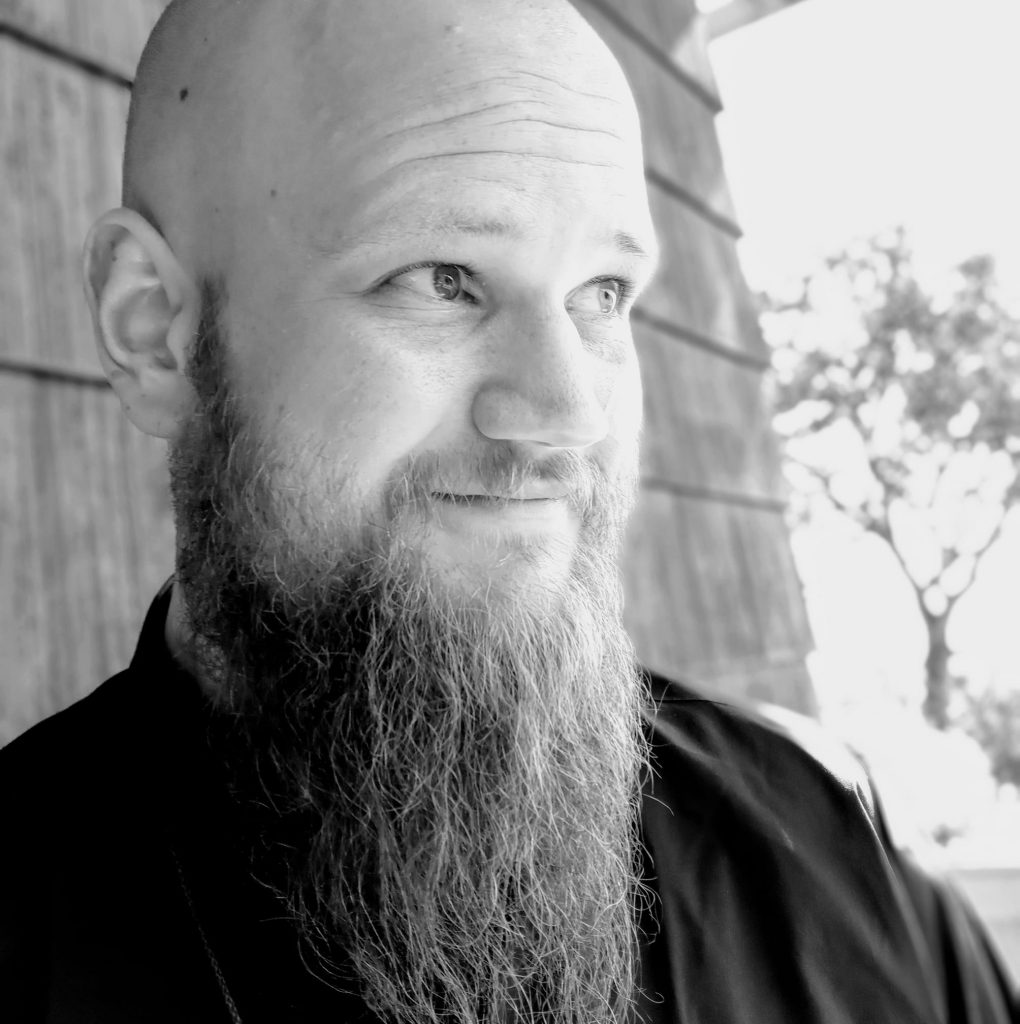Rev. Thom Muller

“We are not human beings having a spiritual experience, but spiritual beings having a a human experience.” (1)
-Pierre Teilhard de Chardin
Teilhard de Chardin is a mystic whose story and ideas may sound somewhat familiar to Swedenborgians. A renowned natural scientist and philosopher, who saw in the natural world a reflection of the spiritual, who viewed human biological evolution as a holistic process which corresponds directly to our spiritual evolution.
De Chardin believed that the natural world is, in fact infused with, and has its source in the divine, something he called the “primacy of the spiritual”. He saw in the figure of Jesus Christ an inner, universal, cosmic reality that is accessible to all, and believed that it is not through seclusion from, but through loving, creative engagement with the world, that we unite ourselves with the divine. He pushed back against the dogmatism of organized religion, which sought to separate the secular and the spiritual, the scientific and the religious, human progress and regressive backwards-looking church structures. Logically, his ideas got him into big trouble with the establishment.
Sound familiar?
De Chardin was a French Jesuit Philosopher, Theologian and Paleontologist who lived from 1881 to 1955. He has left a major mark on modern western philosophy and theology, far beyond the Christian world. His ideas about the nature and development of consciousness, an evolutionary vision of human spiritual growth, the role of the divine in the
To De Chardin, the story of human evolution, evolution in general, is a creative process of God-realization. The development of homo sapiens represents a new stage of cosmic revolution, because of our capability to act on free will and altruism. Rather than using the term “cosmos” to describe cosmic reality, he uses the term “Cosmogenesis”, because to him, the cosmos is not static and fixed, but constantly moving, co-evolving, co-creating.
In what is considered by many to be his magnum opus, The Phenomenon of Man (More recently translated as The Human Phenomenon), he writes:
“To create, to fulfill, and to purify is, for God, to unify it by uniting it organically with himself. How does he unify it? By partially immersing himself in things, by becoming ‘element’, and then, from this point of vantage in the heart of the matter, assuming the control and leadership of what we now call evolution […] The human group is, in fact, turning, by planetary arrangement and convergence of all elemental terrestrial reflections, towards a second critical pole of reflection, of a collective and higher order.” (2)
This echoes Swedenborg’s assertion that
“The universal end, that is, the end of all things of creation, is that there may be an eternal conjunction of the Creator with the created universe; and this is not possible unless there are subjects wherein His Divine can be as in Itself, thus in which it can dwell and abide. In order that these subjects may be dwelling-places and mansions of Him, they must be recipients of His love and wisdom as of themselves; such, therefore, as will elevate themselves to the Creator as of themselves, and conjoin themselves with Him. […] By means of this conjunction, the Lord is present in every work created by Him.” (3)
His view of the future of humanity, like that of Swedenborg, is fundamentally optimistic, and fundamentally pro-gressive. He believes that the ultimate destiny of evolution is a state of Christ-consciousness, and actualisation of the Christ within, something he calls the “Omega Point”, a state of collective union, of collaboration.
The human mind, and specifically the interaction of human minds in the context of ever-increasing technological advances, and ever-increasing exchange of ideas (perhaps best exemplified by the Internet, which didn’t yet exist in his time) is not seen as some kind of movement away from nature or the divine, but as an important step in our collective evolution. A layer of reality which he calls the Noosphere (derived from atmosphere and biosphere, from the Greek “nous” meaning “mind”).
Now, this may, to some, come off as a hyper-intellectualized scientific approach to philosophy and theology, and it certainly has, just like Swedenborg’s work, a strong aroma of natural science. One might ask, “where is the heart in this supposed mysticism?!” When we think of mysticism, we tend to think of an intensely personal, intimate, affective kind of approach, not an abstract, cold analysis of empirical reality.
This is where the heart is so important. While the cognitive does play a major role in this unitive process, it is ultimately the work of love. It is neither a mere intellectual nor technological evolution, but an evolution of the heart, where cognitive advancement creates a dynamic unitive process, becoming one in and with active, unconditional love, as modeled and embodied by the Christ. It is in fact this love which is the driving force behind both our inner inner and outer evolution. To de Chardin, the process of creation is a process of love binding all elements together in a fluid, continuous dynamic.
And what this Christ-love means, to him, is a state in which “the infinite and the intangible can be lovable, or that the human heart can beat with genuine charity for a fellow being”.
Just like in Swedenborg’s mysticism, “Christ” is not simply a person or a deity, but a concrete state which can dwell within and all around us. It is not a doctrinal or religious assertion either, but a universal condition. And that brings us back to the symbol of the sacred heart.
Teilhards personal devotion to the Sacred heart was intensified when he had a mystical experience when looking at Henri Pinta’s painting of the Sacred Heart of Christ:
What moved him about this painting was the radiant quality of the depiction of the heart as a radiating, pulsating, animating symbol of life-giving love. Further, the image of the heart has a universality to it which is not bound by the specifics of doctrine or theology. Rather than a cross, or some other traditional depiction which comes with all kinds of complex and somewhat exclusivist and theological associations, the heart transcends the confines of any specific religion or theological perspective. We all have one, and the imagery is universal.
As the biographer Robert Speaight writes:
“What attracted him to the Sacred Hearth was its symbolic power and its superhuman appeal – the discovery ‘of an element even more determinate, more circumscribed, than your humanity as a whole’.
The Sacred Heart . . . was for Teilhard a means of devotional escape from whatever was ‘too narrow, too precise, and too limited’ in the traditional image of Christ.” (4)
— “The Life of Teilhard de Chardin” by Robert Speaight, p. 128
The Cosmic heart of Christ then becomes a universal symbol for the unifying and animating force of God, deeply and fundamentally immersed into the human experience, at its very center and as the source of all that truly is, and at the same time, it becomes an image of the ultimate potential, the co-creation of God-realization, the realization of the indwelling presence of God at the center of all that is. Not a static, cold entity, but a moving, pulsating, enlivening, and most importantly and most essentially loving source which is in dynamic union with the many elements of the human spiritual body.
Let us meditate on the mystical significance of the symbol of the Cosmic Sacred Heart. Let’s open ourselves up to its vision of true transformation, of distinguishable oneness, and of a creative, gradual, evolutionary path towards true wholeness.
(1) attributed to Pierre Teilhard de Chardin in: Furey, Robert J.. The Joy of Kindness. United States: Crossroad, 1993.
(2) Teilhard de Chardin, Pierre. The Phenomenon of Man. United Kingdom: HarperCollins, 2008.
(3) Swedenborg, Emanuel. Divine Love and Wisdom. West Chester: Swedenborg Foundation, 2010. §170
(4) Speaight, Robert. The Life of Teilhard de Chardin. United States: Harper & Row, 1967.

Rev. Thom Muller is pastor at the Swedenborgian Society of the East Bay at Hillside, an Urban Sanctuary, in El Cerrito, CA, as well as senior editor of Our Daily Bread. His passions include the intersection of spirituality and psychology, interfaith theology, and the Western esoteric tradition. A native of Germany, Rev. Muller was ordained into the ministry of the Swedenborgian Church of North America in 2016, upon receiving his theological education at Bryn Athyn College and the Pacific School of Religion in Berkeley, CA.